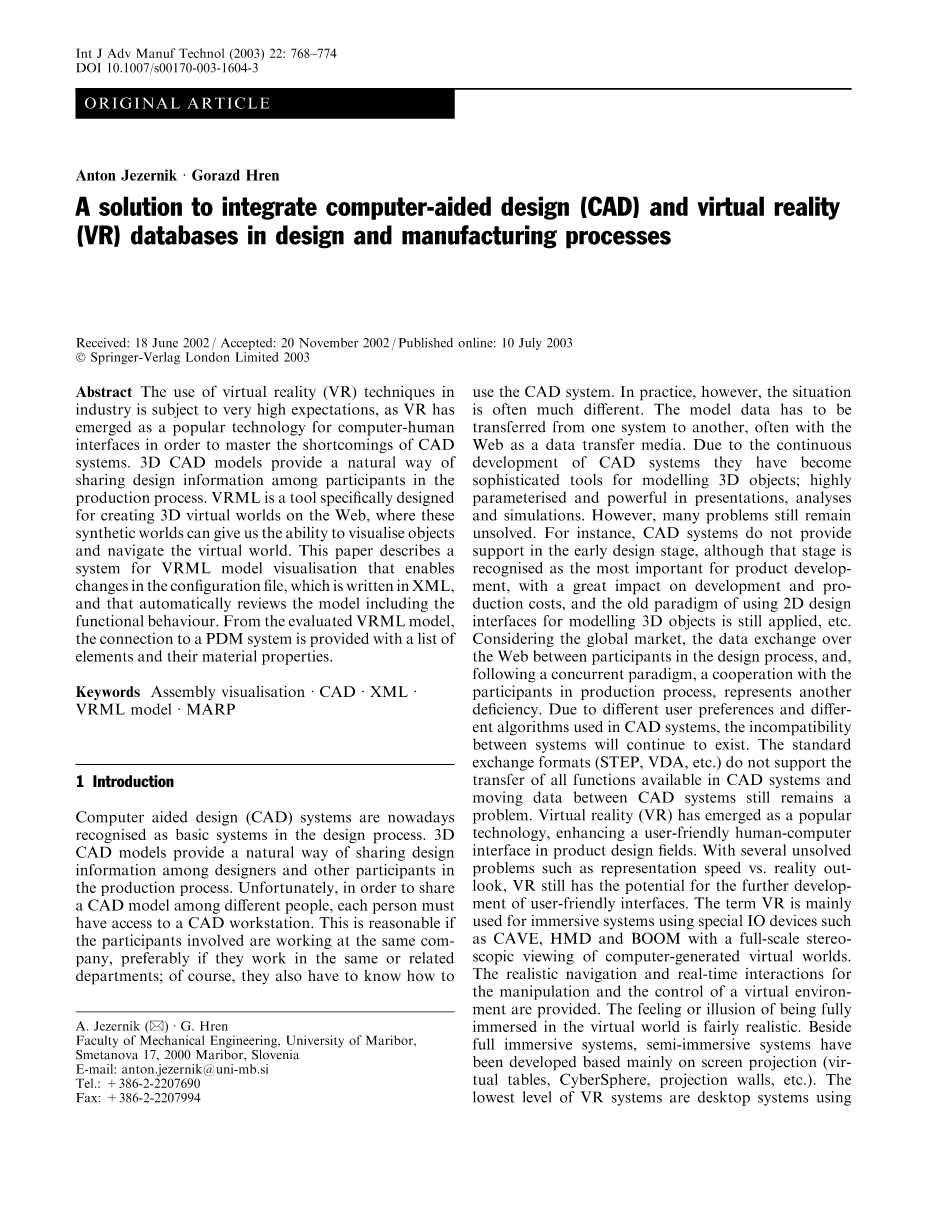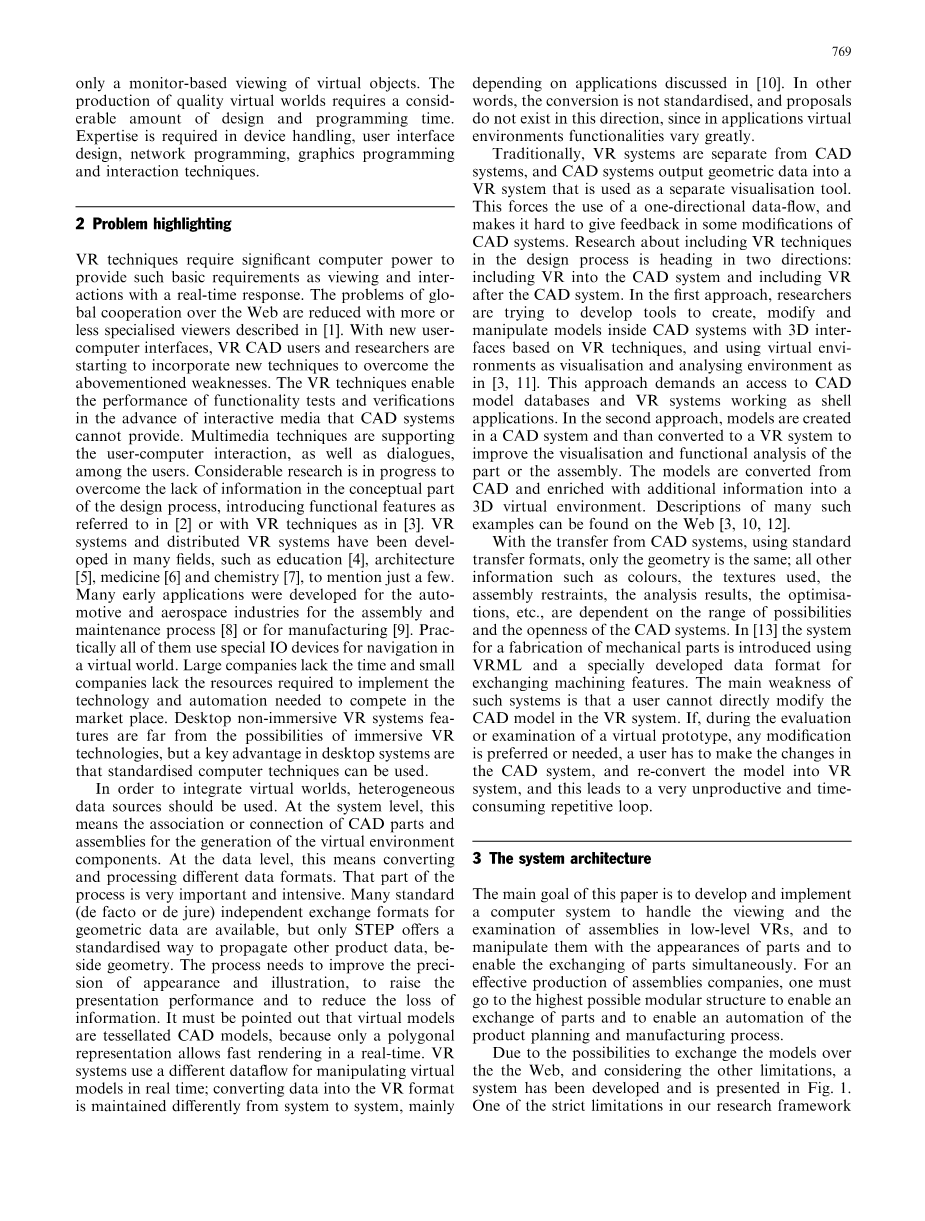文献翻译
1、英文文献
ORIGINAL ARTICLE
A solution to integrate computer-aided design (CAD) and virtual reality(VR) databases in design and manufacturing processes
Received: 18 June 2002 / Accepted: 20 November 2002 / Published online: 10 July 2003 Springer-Verlag London Limited 2003
Abstract The use of virtual reality (VR) techniques inindustry is subject to very high expectations, as VR has emerged as a popular technology for computer-human interfaces in order to master the shortcomings of CAD systems. 3D CAD models provide a natural way of sharing design information among participants in the production process. VRML is a tool specifically designed for creating 3D virtual worlds on the Web, where these synthetic worlds can give us the ability to visualise objects and navigate the virtual world. This paper describes a system for VRML model visualisation that enables
changes in the configuration file, which is written in XML,and that automatically reviews the model including the functional behaviour. From the evaluated VRML model,the connection to a PDM system is provided with a list of elements and their material properties.Keywords Assembly visualisation (CAD amp;XML )VRML model MARP
1 Introduction
Computer aided design (CAD) systems are now adaysrecognised as basic systems in the design process. 3D
CAD models provide a natural way of sharing design information among designers and other participants in the production process. Unfortunately, in order to share a CAD model among different people, each person must have access to a CAD workstation. This is reasonable ifthe participants involved are working at the same company,preferably if they work in the same or related departments; of course, they also have to know how to use the CAD system. In practice, however, the situation is often much different. The model data has to be transferred from one system to another, often with the Web as a data transfer media. Due to the continuous development of CAD systems they have become sophisticated tools for modelling 3D objects; highly parameterised and powerful in presentations, analyses
and simulations. However, many problems still remain unsolved. For instance, CAD systems do not provide
support in the early design stage, although that stage is recognised as the most important for product development,with a great impact on development and production costs, and the old paradigm of using 2D design interfaces for modelling 3D objects is still applied, etc.
Considering the global market, the data exchange over the Web between participants in the design process, and,following a concurrent paradigm, a cooperation with the participants in production process, represents another deficiency. Due to different user preferences and different algorithms used in CAD systems, the incompatibility between systems will continue to exist. The standard exchange formats (STEP, VDA, etc.) do not support the transfer of all functions available in CAD systems and
moving data between CAD systems still remains a problem. Virtual reality (VR) has emerged as a popular
technology, enhancing a user-friendly human-computer interface in product design fields. With several unsolved problems such as representation speed vs. reality outlook,VR still has the potential for the further development of user-friendly interfaces. The term VR is mainly used for immersive systems using special IO devices such as CAVE, HMD and BOOM with a full-scale stereoscopic viewing of computer-generated virtual worlds.The realistic navigation and real-time interactions for the manipulation and the control of a virtual environment are provided. The feeling or illusion of being fully immersed in the virtual world is fairly realistic. Beside full immersive systems, semi-immersive systems have been developed based mainly on screen projection (virtual tables, CyberSphere, projection walls, etc.). The
lowest level of VR systems are desktop systems using only a monitor-based viewing of virtual objects. The production of quality virtual worlds requires a considerable amount of design and programming time.
Expertise is required in device handling, user interface design, network programming, graphics programming and interaction techniques.
2 Problem highlighting
VR techniques require significant computer power to provide such basic requirements as viewing and interactions with a real-time response. The problems of global cooperation over the Web are reduced with more or less specialised viewers described in [1]. With new usercomputer interfaces, VR CAD users and researchers are starting to incorporate new techniques to overcome the abovementioned weaknesses. The VR techniques enable the performance of functionality tests and verifications in the advance of interactive media that CAD systems cannot provide. Multimedia techniques are supporting the user-computer interaction, as well as dialogues, among the users. Considerable research is in progress to overcome the lack of information in the conceptual part of the design process, introducing functional features as referred to in [2] or with VR techniques as in [3]. VR systems and distributed VR systems have been developed in many fields, such as education [4], architecture [5], medicine [6] and chemistry [7], to mention just a few. Many early applications were developed for the automotive and aerospace industries for the assembly and maintenance process [8] or for manufacturing [9]. Practically all of them use special IO devices for navigation in a virtual world. Large companies lack the time and small
companies lack the resources required to implement the technology and automation needed to compete in the market place. Desktop non-immersive VR systems features are far from the possibilities of immersive VR technologies, bu


英语原文共 7 页
资料编号:[4746]


